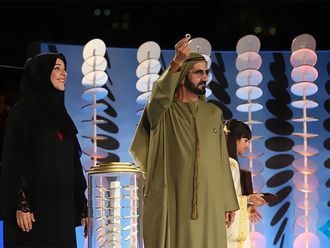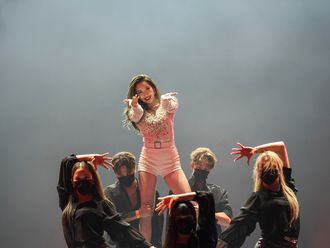
Who says solar panels must always be the same dull shade of bluish grey? Certainly not Harm Jeeninga, who shows me pristine white boards that could lend a distinctive touch to any architectural edifice while raising its energy credentials. If white’s not your thing, how about a mashrabiyya pattern?
Other plates developed by Jeeninga’s colleagues at the Energy Research Centre of the Netherlands (ECN) feature a range of geometric designs. “We can change it to patterns found in the Middle East, or even to a [corporate] logo,” the Director Program Development and Director Business Development at ECN told GN Focus in The Hague earlier this year.
“Our aim is to showcase these panels at Expo 2020 Dubai — maybe even install them on the Dutch pavilion building,” he said. “If we can boost the uptake of solar panels by creating architecturally pleasing building solutions, and move energy usage in a more sustainable direction, that’s fine with us.”
The changes in colour and pattern only reduce energy absorption by a few percentage points, and when spread over the roof of a small home, the photovoltaic cells could generate as much as 7,000 kilowatt hours a year. “If you integrate them into the walls, the energy yield is much higher.”
UAE residents each consume approximately 20,000 kilowatt hours annually, official data shows.
Sustainable quest
Jeeninga’s organisation is one of several across the Netherlands working to find sustainable answers to the planet’s future needs. With the world population projected to rise to nine billion by 2050, the demand for resources is expected to intensify considerably. Sector-specific tactics are no longer enough.
Water, energy and food security are intimately linked and actions in one area have demonstrable effects on the others. Governments everywhere have embraced a cohesive, three-pronged approach to this nexus. The Netherlands is a champion of this relatively new line of response and its expertise in the area ranges from research to policy.
The country now hopes to bring some of those solutions to the UAE and the wider Middle East and promote sustainable responses to the use of natural resources.
To this end, Expo 2020 remains a principal vehicle for collaboration, says Hans Sandee (right), Consul General of the Kingdom of the Netherlands in Dubai and Commissioner General Expo 2020. The water-food-energy nexus is the theme of the Dutch participation at the event, which has sustainability as a key theme.
“The Gulf is investing heavily in economic diversification, innovation and sustainability — areas in which the Netherlands has a lot to offer,” Sandee tells GN Focus.
“Water, food and energy are highly relevant for the Gulf region and beyond. In order to effectively achieve the Gulf countries’ ambitions, these sectors must be connected. The Netherlands has the required expertise to do this and is keen on sharing it. Expo 2020 provides a platform for the Netherlands to share its latest innovations on water, food and energy and to engage in debates about key issues facing the world today and in the future.”
The list of organisations comprising the Dutch delegation has yet to be finalised, says Pieter Ton, Communications Manager at the Netherlands’ Ministry of Foreign Affairs, but it is expected to showcase the latest green technologies.
Knowledge partners
In February last year, the two nations agreed to exchange knowledge and expertise on innovation in areas including food, water, transport, logistics and energy.
Several other Dutch innovations could find applications in the Gulf, many of them drawing from the same plentiful resource that the UAE shares with the Netherlands: sea water.
The first floating solar power station, launched in February, is expected to be able to generate clean energy at sea within the next three years. The €1.2-million (about Dh5.4 million) Sun at Sea, a small-scale demonstration farm, will operate 30 sq m of panels by this summer. Its eventual aim is to harvest solar energy from 2,500 sq m of panels on the North Sea.
Last May, two Dutch companies were among the ten annual winners of the $1-million (Dh3.67 million) Mohammad bin Rashid Global Water Award.
Elemental Water Makers, a young start-up, was recognised for a plant on the British Virgin Islands that produces 12,500 litres of fresh water each day using only 12 kilowatt peaks of solar energy. By using pressurised seawater in a process of reverse osmosis, the company is able to keep costs down, said Managing Director Sid Vollebregt (right) told GN Focus in Delft.
The company has projects in Belize, The Philippines, Indonesia and Mozambique and would like to be able to bring its technology to the UAE. Vollebregt says the company can deliver the most savings if it is involved at the concept stage but since project developers may not be able to invest the entire project amount at the start, he and his partners are moving towards a model where the company owns the technology but the client pays for the water. “With our technology, we can help realise savings of up to 70 per cent over time,” he said.
The Netherlands Organisation for Applied Scientific Research (TNO) was awarded for a membrane that distils sea water into pure drinking water. The MemPower technology produces electricity instead of consuming it as as compared to existing desalination techniques, which tend to be complex, expensive and energy-intensive.
Ocean life is also being examined for potential use, and seaweed or kelp finds application on two fronts: as food and as fuel. ECN officials showed GN Focus how different varieties of macroalgae is already making it to plates worldwide.
Joining the Japanese cuisine staples of wakame and nori is dulse, a leafy and lettuce-like plant that’s winning fans for its sensory resemblance to bacon.
Sustainable innovation award nominee Seaweed Harvest Holland has experimented with growing 175 different types of seaweed in the former Eastern Scheldt estuary in Zeeland province, where it is able to grow 100,000 kilos per hectare per year.
“As a superfood, seaweed is rich in minerals and can be used as an alternative to salt and as a binder in cooking,” says owner John van Leeuwen. Other uses lie in candy, sugar alternatives such as mannitol, and even weed burgers.
While he admits more tests need to be done before seaweed can feed the Middle East, van Leeuwen identifies areas such as Morocco and the Red Sea off Saudi Arabia as potential farm sites.
The ECN has also shown how it can generate energy from ocean kelp or seaweed, with farms in the North Sea expected to provide as much as green power as wind turbines by the year 2020.
“Biomass from seaweed can provide energy for the entire population of the Netherlands,” says Jaap Willem van Hal, Innovation Manager Biorefinery, ECN.
The EU-funded project currently has 5,000 square kilometres under cultivation, which is capable of producing upto 350 petajoules of energy. One petajoule of energy is judged enough to fuel a small regional town such as Khor Fakkan.
Tomorrow's road
Over the next couple of decades, the arteries connecting Dubai and Abu Dhabi to Khor Fakkan could be energy units themselves. One of the more glamorous projects at TNO has been SolaRoad, where photovoltaic cells are laid down over the asphalt, to transform sunlight into energy.
In 2009, a 70m bike path was found to produce 9700kW hours over the course of a year, or enough to power three households in the Netherlands.
“The Netherlands has a road network of 140,000 kilometres, more than all the rooftop solar panels combined. If we cover just one-third of that network with solar panels, we could power 8 million electric cars, or the total number of cars in the country – all without claiming any extra space,” says Dr M.S. Sten de Wit, Lead Innovator and Strategic Business Developer at TNO. “The SolaRoad is both the future of roads and an exciting road to the future.”
Sandee says the aim behind collaborations with Gulf states is to create a more sustainable future worldwide. “That is why we’re reaching out to Expo 2020 in the Gulf where the Dutch pavilion will be the fertile ground and basis for building meaningful relations and future connections in the Gulf region and beyond. The Netherlands wants to connect the future with the now.”








